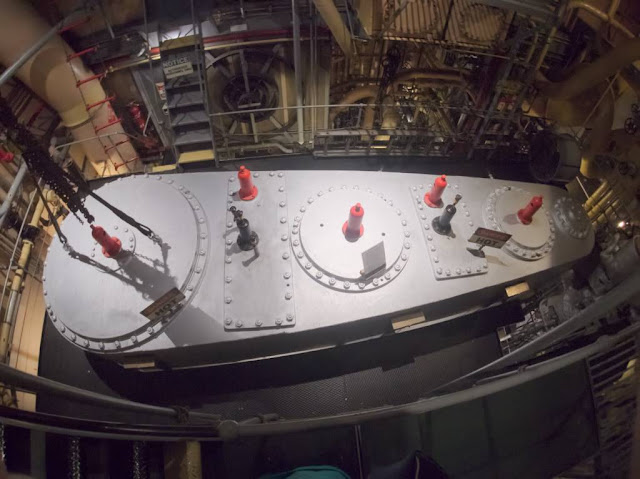 |
| Balclutha, a full-rigged ship built in Scotland, 1887. |
Once upon a time San Francisco wass the most important port on the United States West Coast. No surprise then that there are several interesting museum ships there. If you're as interested in them as I am, you can easily spend a whole
week day exploring them.
The
San Francisco Maritime National Historical Park, another gem ran by the National Park Service, is situated on the touristy Fisherman's Wharf. It includes several museum vessels, many of which are accessible to visitors. Full-rigger
Balclutha sailed in commercial freight traffic from 1887 to 1930, and has an interesting and eventful history. For example, she was the last ship ever to fly the flag of the independent kingdom of Hawaii. There's a well-designed exhibition in the cargo hold about different cargoes transported by the
Balclutha. All of the ship is accessible, but climbing the rigging is prohibited. In the captains's salon, in the galley and in the forecastle the visitors can imagine what it felt like to sail an ocean-going sailing vessel, when trips lasted several months.
 |
| Captain's salon. |
 |
| Crew quarters in the forecastle. I don't think the anchor windlass in the middle of the room did much for comfort. The picture is taken with a fish-eye lens and is therefore distorted. |
 |
| Balclutha's figurehead. |
The paddle-wheel ferry
Eureka is also very interesting, in a completely different way than
Balclutha. She was built only three years later, in 1890, and she's almost as big as the ocean-going fullrigger. She originally transported trainso over the Golden Gate from San Francisco to Sausalito. After the First World War she was converted to a passenger and car ferry. After the Golden Gate Bridge and Bay Bridge were completed in th 1930s, most of the numerous ferries of the San Francisco Bay were decommissioned.
Eureka, however, remained in traffic until 1957.
 |
| Entrance to the Eureka. |
 |
| The car deck. |
 |
| The passenger deck. It only took about half an hour to get from Sausalito to San Francisco, but there was a restaurant serving full meals on the Eureka. |
Technologically
Eureka was quite old-fashioned already when built. Paddle-wheels had largely been replaced by propellers, and the one-cylinder steam engine was based on 18th-century technology. The machinery was simple, and reliable on a vessel designed for continuous short trips. It was important to keep maintenance costs low and time required for repairs short.
 |
| Eureka's engine, picture taken with a fish-eye lens.. |
 |
| The engine explained. |
 |
| The Historical Park's collections include other vessels as well, like thid paddle-wheel tug. |
 |
| The museum, also included in the Historical Park, was under renovation, but we could see some nice scale models in the lobby. This one depicts San Francisco harbor around the 1849 gold rush. The sailing vessel Niantic had arrived from the U.S. East Coast, sailing around Cape Horn. The owners decided to convert it to a shop and tavern - at the time, the potential profit was greater than in shipping industry. |
 |
| Another model featured the crew in masts. |
A few blocks away there's a Liberty-class freight steamer
Jeremiah O'Brien, built during the Second World War. She's not a part of the Historical Park but ran by an association. She is seaworthy and in navigable condition, and does sail every now and then. In her hold visitors can see an exhibition on the Liberty ships, which were built for war material transports. Between 1941 and 1945, 2710 were built.
|
|
Liberty-class freighter Jeremiah O'Brien.
|
 |
| The telegrapher's cabin. |
 |
| Fist mate's cabin. The radio equipment is not original but for the modern use of the ship. |
 |
| The Jeremiah O'Brienin operational main engine. |
 |
| The rescue ladder of the engine room. Would you want to climb this to escape a burning engine room after the ship has been hit by a torpedo? |
 |
| There's another WWII vessel next to the Jeremiah O'Brien, the submarine USS Pampanito. |
Fisherman's Wharf is probably the most touristy area of San Francisco and it is not my favorite place in the city. The museum ships are great, but in addition to them there are mostly plastic, overpriced theme restaurants and souvenir shops. However, there is one more reason to visit the Fisherman's Wharf:
The sea lion colony on Pier 39. Jolly creatures. Smelly, though.
 |
| Every now and then one should show off for the tourists... |
 |
| ...but mostly it's best just to relax. |
We visited the ships on June 5th and 28th 2015.




















Ei kommentteja:
Lähetä kommentti